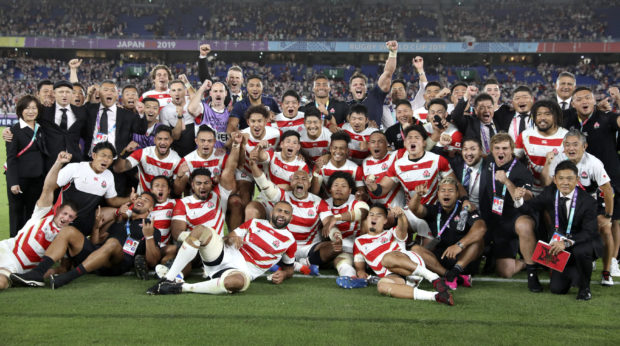The recriminations can wait a little while, a few paragraphs at least. Scotland lost their crunch match with Japan in Yokohama last night due to the whole, undeniable cliché – the Japanese just wanted it more.
In truth, there was little way the Scots could have wanted this victory more than the Japanese. Allied to the always intense drive to prove themselves, and the specific advantage of playing a World Cup at home – worth 10-20 per cent extra to a team, believed Gregor Townsend – there was also the aftermath of Typhoon Hagibis.
No, not the doubts the weather caused to the game and the wholly contrived “backlash” against the Scots’ stance about a possible cancellation, which was only designed to ensure the game was played and get their fate quite properly decided on the field of play.
The tragedy of the typhoon and the 23 deaths and counting resulting from it – many are also still missing – was an additional incentive for the Japan team. Captain Michael Leitch said it felt they were playing for a wounded country, and for their lost compatriots.
In such circumstances Scotland couldn’t hope to compete for superior motivation. Japan were already on a mission and suddenly, in the space of a week, it became almost a crusade.
At 28-7 down just two minutes into the second half, it seemed Scotland would be wholly overwhelmed. It was familiar sickening feeling, the Scots teetering on the brink of a precipitous collapse to humiliation.
This simply happens far too often to be a coincidence. Twice at Twickenham on the last two visits over two years, twice at Yokohama in this past month, at Nice and Paris this year, and at Cardiff last year.
The psychological issues of this Scotland team’s regular collapses have to be Townsend’s main concern moving forward, and a thorough examination as to the reasons why they don’t seem to occur at Murrayfield.
This time, at least, Scotland rallied, largely due to the dogged persistence of a few of the younger players who have seeped gradually into a team that wasn’t supposed to be in quite this much transition yet.
Jamie Ritchie had another monumental game, Magnus Bradbury was a willing and dogged competitor, George Horne, Zander Fagerson and Scott Cummings lifted the performance when they came on as replacements.
Transition will move ahead now, as it does at the end of every Rugby World Cup cycle. Many of those young players will surely be seasoned internationals in 2023 in France. Finn Russell – as maddeningly mercurial as ever yesterday – Stuart Hogg and Jonny Gray will form the core of the experience then, one would imagine.
Will Townsend be leading them? The pressure is now firmly on him.
A new and different plan has to come out of this. His strategy of more kicking has not been as successful as his first year in the job. Japan showed what speed and execution and fitness can do for teams that don’t have a whole lot of muscle, and Scotland can learn from that.
If Townsend is flexible, with new personnel, he can still be a successful Scotland coach – he’s still the most successful in terms of win-loss record since professionalism. But we have to see signs of moving forward again in the spring, or the clock will begin to tick louder.
The amazing Japanese
At Friday’s Scotland press conference – the longest in living memory as we were locked indoors on Saturday with no access and CEO Mark Dodson did his spiel as well – every Japanese local media person, without exception, was absolutely certain that this game would take place.
We nodded politely, and nervously. The biggest typhoon in living memory was coming in, and there was a genuine fear among foreigners at what might ensue. We’ve seen what natural disasters have done to civilised communities like New Orleans and Houston in the USA, to Puerto Rico and the Bahamas in the Caribbean.
But in the end, they were right. Japanese society is stoic to the point of being almost rigid, for a start, but they also have a flair for order and organisation, if that’s not a contradiction in terms.
They knew their systems would stand up, practiced over decades and meaning that a typhoon stronger than one that killed thousands in 1958 would result in less than about 300 casualties.
And, they were equally confident that within hours of it sweeping through the venue, they would have everything up and running again so a major sporting event with more than 67,000 attending would go ahead.
It just wouldn’t happen in our country. ScotRail struggle with leaves and the wrong type of snow. Japan has the trains running on time again less than six hours after a natural disaster occurs.
There’s many reasons why this happens, and a lot of them are things that are probably alien to our culture but natural to theirs, largely uncopyable and many you probably wouldn’t really want to copy either.
But it’s still a source of amazement and wonder. Only in Japan.


